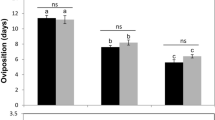Abstract
Seasonally acclimatized adult and immature parasites of the citrus blackfly (CBF),Aleurocanthus woglumi Ashby, were exposed to high or low temperature extremes for 3 h periods. Death of all summer adults ofEncarsia opulenta Silvestri andE. smithi Silvestri occurred between 35° and 40°C. Within CBF hosts,E. opulenta were not able to emerge when temperatures reached between 45° and 50°C. In winter experiments adults of bothEncarsia species succumbed between −5° and −10°C. In a comparison of the 2 seasonal tests, a higher percentage ofE. smithi adults were able to survive both higher and lower temperatures thanE. opulenta, but the main interspecific difference was the ability ofE. opulenta within CBF to survive −10° to − 15°C whileE. smithi did not. Limited data forAmitus hesperidum Silvestri [Hym.: Platygasteridae] indicated that the immatures survived better at low, and not as well at high, temperatures as either species ofEncarsia.
Résumé
Des parasites adultes et des stades immatures de l'Aleurode des Citrus,Aleurocanthus woglumi Ashby déjà acclimatés ont été soumis à des températures extrêmes durant 3 h. La mort de tous les adultes d'été d'Encarsia opulenta Silvestri et d'E. smithi intervenait pour des températures comprises entre 35° et 40°.E. opulenta etE. smithi se trouvant à l'intérieur de leur hôte sont incapables d'éclore lorsque les températures atteignent entre 45° et 50°. Au cours d'expériences hivernales, les adultes des 2 espèces d'Encarsia meurent entre −5° et −10°. En comparant les tests de ces 2 saisons, il apparaît qu'un pourcentage plus élevé d'adultes d'E. smithi est capable de survivre à des températures à la fois plus fortes et plus basses que les adultes d'E. opulenta, mais la principale différence interspécifique était la capacité d'E. opulenta de survivre à l'intérieur de son hôte à des températures de −10° à −15°, tandis qu'E. smithi ne le pouvait pas. Des observations limitées relatives àAmitus hesperidum Silvestri [Hym.: Platygasteridae] indiquent que les stades immatures survivent mieux aux températures basses et pas aussi bien aux températures élevées, que ne le font les espèces d'Encarsia.
Similar content being viewed by others
References
Arrieta Mateos, D. L. — 1961. Control biologico de la mosca prieta en Mexico. —Fitofilo, 16, 5–41.
Cherry, R. H. — 1979. Lethal temperatures of citrus blackflyAleurocanthus woglumi [Hom.: Aleyrodidae] and its parasite,Amitus hesperidum [Hym.: Platysgasteridae]. —Entomophaga, 24, 35–39.
Dowell, R. V., Cherry, R. H., Fitzpatrick, G. E., Reinert, J. A. & Knapp, J. L. — 1981. Biology, plant-insect relations, and control of the citrus blackfly. —Fla. Agric. Exp. Sta. Tech. Bull., 818, 49 pp.
Dowell, R. V., Fitzpatrick, G. E. &Reinert, J. A. — 1979. Biological control of citrus blackfly in southern Florida. —Environ. Entomol., 8, 595–597.
Flanders, S. E. — 1969.Herbert D. Smith's observations on citrus blackfly parasites in India and Mexico and the correlated circumstances. —Can. Entomol., 101, 467–480.
Jiménez Jiménez, E. — 1961. Situacion de la mosca prieta (Aleurocanthus woglumi Ash.), de los citricos en Mexico. —Fitofilo, 14, 39–40.
Ketner, C. F. &Rosier, J. G. — 1978. Citrus blackfly controlled biologically. —Tex. Agric. Prog., 24, 19–20.
Nguyen, R., Brazzel, J. R. &Poucher, C. — 1983. Population density of the citrus blackflyAleurocanthus woglumi Ashby [Homoptera: Aleyrodidae], and its parasites in urban Florida in 1979–1981. —Environ. Entomol., 12, 878–884.
Smith, H. D. — 1958. Las interrelaciounes de los enemigos naturales de la mosca prieta de los citricos en Mexico. —Fitofilo, 11, 31–36.
Smith, H. D., Maltby, H. L. & Jimenez. E. — 1964. Biological control of the citrus blackfly in Mexico. —U.S. Dep. Agric. Tech. Bull., 1311, 30 pp.
Summy, K. R., Gilstrap, F. E., Hart, W. G., Cabellero, J. M. &Saenz, I. —1983. Biological control of citrus blackfly in Texas. —Environ. Entomol., 12, 782–786.
Author information
Authors and Affiliations
Additional information
Florida Agricultural Experiment Station Journal Series # 5549.
Rights and permissions
About this article
Cite this article
Thompson, C.R. Temperatures lethal for citrus blackfly parasites,Encarsia opulenta andE. Smithi [Hym.: Aphelinidae] . Entomophaga 30, 87–91 (1985). https://doi.org/10.1007/BF02372288
Received:
Accepted:
Issue Date:
DOI: https://doi.org/10.1007/BF02372288



